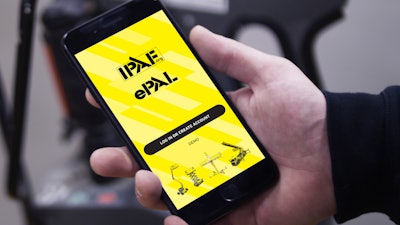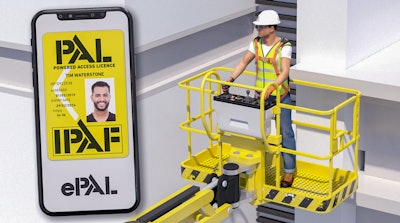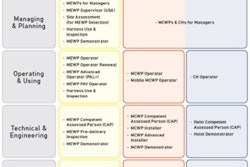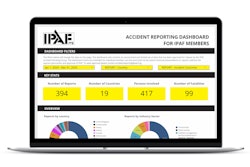
If you were to stack the 170,000 plastic PAL Cards IPAF issued in 2019 one on top of the other (assuming you had the patience and the skill), it would create a tower 425-feet high. That’s higher than even the tallest MEWPs can reach and partially explains why IPAF decided to bring its globally recognized operator license card into the digital age.
When joining IPAF as chief executive and managing director in December 2019, Peter Douglas moved the idea of digitalizing the PAL Card to the top of the agenda. In Q2 2021, despite more than a year of disruption caused by the coronavirus pandemic, that vision has become a reality with the creation and roll out of the ePAL Mobile App.
“Our main aim is to improve safety in our industry,” says Douglas. “But having this app will improve other things as well, certainly in terms of sustainability and greater efficiency in certifying our training program.”

IPAF has worked in partnership with member firm Trackunit, a Denmark-based tracking systems specialist, to develop the app and the platform on which it is based. But – and this is a point that Douglas and Søren Brogaard, CEO of Trackunit, are both keen to stress – IPAF retains ownership of ePAL. Trackunit’s role is to help develop the platform and the app that sits on top of it (see sidebar).
Important App Features
The first release of the app, which is available on iOS and Android, will be broken down into three main sections: Experience, Training, and Safety. The Training section holds a digital version of the PAL Card and other IPAF training qualifications, which can easily be shared with site managers or anyone who needs to view or verify it. It also holds details of the training company that provided the operator’s training. The app will have the capability to remind operators when their license is coming up for renewal and prompt them to contact the training center.
Operators with existing physical PAL Cards will be able to enter their details to obtain their digital card or simply touch the card to their mobile device to have their digital card created automatically if their phone has nearfield communication (NFC) technology.
If you were to stack the 170,000 plastic PAL Cards IPAF issued in 2019 one on top of the other, it would create a tower 425-feet high.
The Experience section of the app is the one IPAF believes will be used most often. It essentially replaces the physical logbook, which Douglas concedes often ends up wasting away in a desk drawer or glove compartment. It is a tool to document familiarization and operational experience of the operator.
MEWP operators will be able to select which type of machine they are working on before recording the time spent on it. “With the app, it will be much easier for operators to log their time on a particular machine and that will help to build a better picture of their equipment experience, which they can then show to contractors when they are on site,” he explains.
It will also generate anonymized information to show IPAF how frequently different types of machines are used, how much time is spent on them, and in what country, which IPAF hopes will inform better industry safety initiatives over time.
The app will be linked to IPAF’s accident reporting portal, updated last year to make for an improved reporting process and user experience (see page 16 for more). When it comes to the Safety section of the app, there will be a feed of tailored content aimed at the operator.
“It will be informed by all the things we know can go wrong on sites. It will reinforce the messages that we get from our accident reporting portal, using our Andy Access posters, technical guidance documents, and Toolbox Talks,” says Douglas.
“We will also be reminding people of the importance of doing daily checks, the importance of looking after batteries, of wearing the correct PPE, and fall-arrest devices – all the things that you would expect to enhance safety and productivity when working at height,” he adds.
The First Step on a Long Journey
Douglas hopes the launch will meet with an enthusiastic reception. A recent survey of 1,200 operators by IPAF found that 98 percent said they would download and use an app. “That was an incredible response,” Douglas says.
“We didn’t think it would be anywhere near that if we are being honest. We are not kidding ourselves that we will get to 98 percent take-up overall straight away, but that was a really strong response, and we feel we are producing something that will grow and grow.”

Initially, the app will be in English before being rolled out in other languages. Meanwhile, the organization has a contract with Trackunit for ongoing development. “Over time, the app will be able to offer contactless access control over the phone,” says Brogaard.
“The way to look at this is that, on this platform, we will build applications and solutions, access control being one, the logbook experience record and ability to directly communicate safety information being another. It is the first step on a long journey. We aren’t expecting an industry that hasn’t traditionally worked in a digital way to go digital overnight. It will take four or five years. With the help of manufacturers, contractors, and rental companies, we have a platform on which we can build experiences and apps, and the IPAF ePAL app is the first expression of that.”
Douglas is eager to see pre-use inspection be incorporated in the future, as well as machine familiarization videos. He sees potential for a site-survey tool that allows users to determine what machine they should use, which will help cut down on accidents caused because the wrong type of MEWP was selected.
He is also excited by the environmental benefits of cutting down on all those pieces of plastic, paper logbooks, and the carbon emissions associated with their distribution. “All of it can be put into a neat app that you put on your smartphone – technology that almost everyone has in their pocket,” he says.
↘ Key Benefits of the ePAL App:
- Direct communication of training and safety messages to operators
- Accurate, up-to-date logbook information
- Reduction in plastic, paper, administrative work, and CO2 emissions
- Simple and easy to use
- Reliable proof of operator qualifications and experience




















